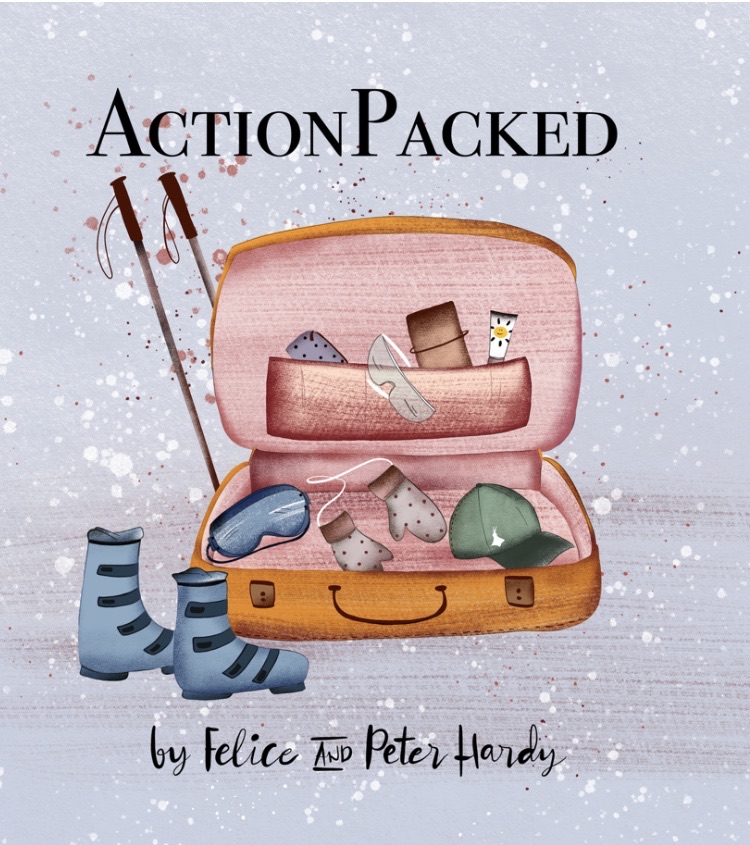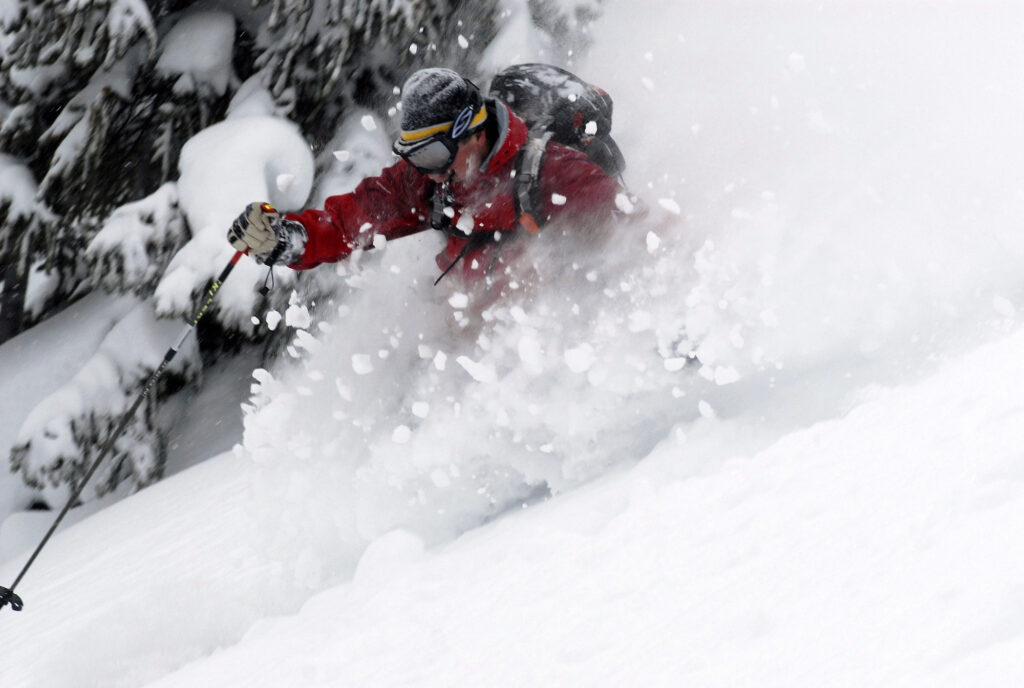
Dan in the powder
Peter Welcome to our travel podcast. We’re specialist travel writers. And we’ve spent half a lifetime exploring every corner of the world.
Felice So we want to share with you some of our extraordinary experiences and the amazing people we’ve met along the way.
Peter This week were high in the Rocky Mountains, in the ski resort of Big Sky, Montana, talking to Dan Egan. Dan’s one of the greatest stars of American extreme skiing, and he’s appeared in no less than 14 Warren Miller movies and for the past 30 years, together with his brother John, he’s been jumping off cliffs and making stomach churning first descents of quite impossibly steep mountains all over the world. Dan, welcome to our podcast. You made a golden career out of being a self-confessed ski bum. How did this all come about?
Dan Well, you know, we were a family of seven kids who lived on a hill. And my mom just threw us all outside every day she could. And in the wintertime, we would sled, ski down that hill and build a jump over the driveway into the neighbour’s yard, and over the fence, and we just played outside all the time. We lived just two miles outside the city of Boston and just grew up playing outside.
Peter Now, you were the youngest. When our kids were growing up, they’d spend the whole morning building a kicker with friends. Then they’d get the youngest to do the first jump. If he landed and survived, then the rest of them would go themselves.
Dan Yes, I was offered the test, the test dummy for sure…and a lot of fun.
Felice So how old were you when you first put on skis?
Dan Well, I like to say my first proper ski was probably five when I went to a ski area.
Prior to that, I was flipping and flopping down the hill at the house. But there was a ski club in Boston, the Blizzard Ski Club, and you could catch the bus out by the highway and they would take you up to north New Hampshire to ski. And my mom joined all the kids up for the club and she put us all on the bus, she put my dad on the bus so she could have a day off and we would go up north with that ski club and we would ski all day.
And being part of the club is you had to take a lesson, so I took proper ski school lessons till I was 16. And that really was the beginning and the foundation. I learned how to ski through the Austrians who ran the ski schools in New England at the time, and it was amazing.
Peter So we’re talking about thin skis, aren’t we? We’re going back to those days and much of your early career, some of the big Warren Miller films were on thin skis where you really got in the snow, you didn’t just sit on the top of it.
Dan Well, it’s a fair statement. I don’t think really until pretty much after the peak of my career, I started skiing on shaped skis or fat skis. Prior to that, it was all straight skis. I filmed this year again for Warren Miller here in Big Sky, Montana, for Future Retro. And I skied the line I hadn’t skied in 25 years. The last time I skied it, I was on straight skis. And what a difference – it’s so amazing.
Of course technology and changes is awesome and it really makes a difference, but on the straight skis, as you guys both know, there was a lot more motion. You had to be very proactive on the straight skis. You couldn’t take things for granted, like slowing down, you know, your speed was really relevant to creating the energy. Popping up and out of the snow was really important.
So often when I meet kids today, they always ask me, ‘Hey, what was your big trick?’ And I always tell them, ‘Staying alive was my trick.’ When you watch the new schoolers today go towards a cliff and they throw their skis sideways and they can almost skid towards the edge, we never had those options. We we were knee-deep, thigh-deep in the snow, hoping for enough speed to clear the rocks below. We were in it. They were they ski on it today.
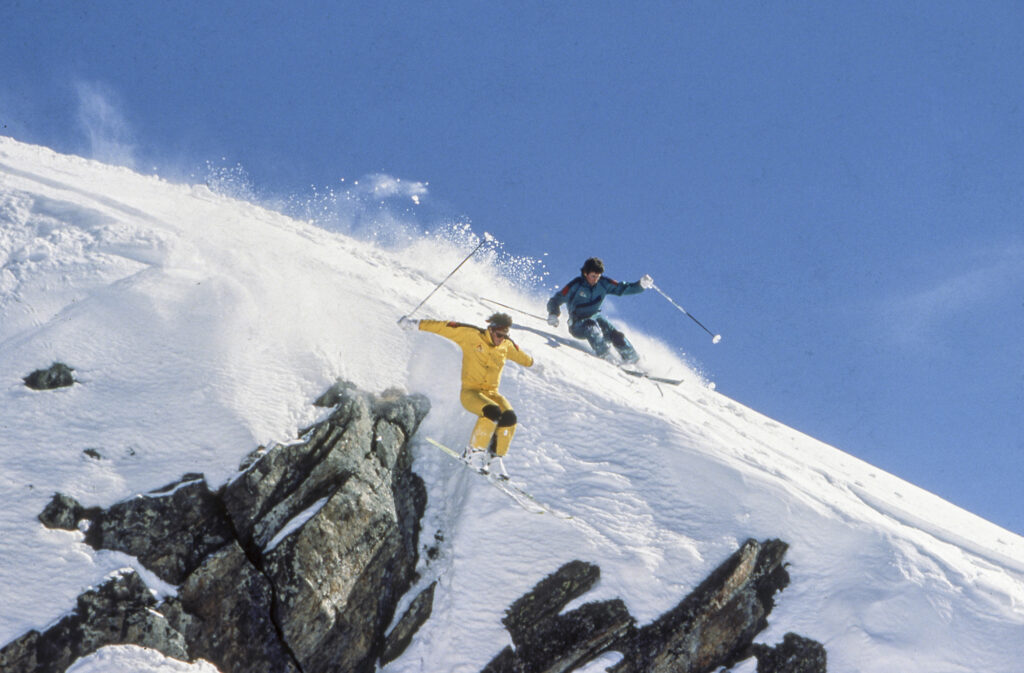
Dan launching off the cornice with John
Peter So were you in on it in Grand Targhee when I know you had a very strange experience with a cornice breaking beneath both you and your brother, right?
Dan Yes, it’s true. That was a big cornice the size of two massive trucks, so to speak. It was over a 500 foot cliff and we were in the snow. We were skiing down along the ridge and as I was skiing, I looked down and I could see daylight. So I saw a hole in the snow. So I leaped over the hole and landed on the cornice that broke. And when you talk about in it, or on it, I was in it. I was submerged in the snow and I felt like I had hit a wind drift. And as I was trying to get up and out, I didn’t realise I was actually skiing off the piece that was breaking back to the mountain.
John, who was in the back and about a turn and a half, two turns behind me, saw it break. As he heads towards the cliff and as the cornice broke, instead of stopping he pushed. And that push saved his life. He gave enough energy to airplane turn in the air and come back to the mountain.
Peter Well, that’s one of the many experiences you had – near-death experiences in lots of ways – but perhaps one of the biggest was on Mount Elbrus. I should explain that Mont Blanc is the highest mountain in Western Europe, but Mount Elbrus is the highest mountain in the whole of Europe.
Dan Yes, that’s true. And down there by Georgia, the Black Sea, it’s off the Caspian Sea and it’s one of the seven summits of the world. And oddly enough, Elbrus kills more people than Everest. On our trip, and back in 1990, that truly was the case – we lost over 30 climbers. There were 50 people trapped in the storm and I was among those trapped. We were trapped somewhere around 17,000 feet and I was 38 hours without food or water.
Felice And how did you survive?
Dan Well, I was with three other climbers from my expedition and we had joined up with a group of Russians and we had dug snow caves for the night. But the snow caves are really spread out and it was 100mph winds, snowed five feet that night. My two fellow climbers went to another snow cave and never told me, so I was abandoned in my cave. And one of the Russians must have taken a head count because he went out in the storm and found my cave, and in the middle of the night came into the cave and I believe saved my life. He huddled with me, warmed me back up, I was having visions, I had seen the bright light. And Sasha said to me, ‘Tonight, we sleep like brothers,’ and we survived the night.
Peter That was quite a life changing experience for you?
Dan It was in a lot of ways. I was young but my brother didn’t want to summit that day and I did. So he was down below. He had rescued other climbers off the mountain during the storm, but from a lower spot. And like I said, I saw the bright lights and it had a major effect on me. The next day, Sasha and I rescued 14 people ourselves and eventually got down off the mountain. But the whole ordeal took 38 hours.
Felice And did you get frostbite or anything like that?
Dan Yes, I have – still even today, my feet all day yesterday were frozen – my feet were severely frostbit, my hands were severely frostbit. One of the climbers from my expedition had severe frostbite that we took down. So there were several injuries in our little group and frostbite was definitely among them.
Peter So you’ve written this book now, 30 Years In A White Haze. Tell us about it?
Dan Well, it’s been 30 years since the Elbrus accident and the white haze sort of sums up the life of following your passion and living on the edge and being a ski bum all these years. Life isn’t always predictable, a lot of changes. And in the book we recap – the Elbrus accident had never been written about. I had put it in one of my ski films early on, The Extreme Dream, but it never fully explained the accident.
So obviously Elbrus is a big part of the book, but really I weave together how two kids from Boston rose to the height that we did through Warren Miller. I mean, we were basically city kids who skied and there were a lot of things that fell into place to make it possible for us to have a pro careers for all this all this time.
Felice And when did your career in skiing begin? When did you start making a living out of skiing?
Dan Well my brother, John, six years older than me, and he was right out of high school moved right to Sugarbush, Vermont in 1976 to be a ski bum. That was a move that really shook our family; we had never thought of anything like that. And I watched my brother go from…he was a great athlete at the time, a good skier, but in a very short time got to pro skier. He competed on a pro mogul tour in the late 70s; he was on the Peugeot pro race tour. He’s still the only person ever to compete on a freestyle tour and a race tour in the same year.
And he did quite well and he also got noticed by Warren Miller in 1979. He’s skied for Warren at Sugarbush. So I had seen that unfold through my teenage years. I would visit John, watch the sort of lifestyle he was living and it was fascinating to me. And so, one year, the pro race came to a small little ski area outside of Boston and John stayed at the family home. And when he was going to the race, he looked at me and said, ‘Dan, today I’m wearing my work clothes.’ And he was in his padded sweater and his padded pants and he had his skis and I was probably 14 and that comment really left a mark on me and like, wow, he’s going to work.
I thought about that, and my thing was soccer. I played American soccer – football over there, of course – but I was a soccer player. And through college, I decided I would try being a ski bum. So after the season, I took some time off from college and moved to Sugarbush. And later that year, we both film for Warren Miller in 1985. It was a very small clip in the film, but that was the beginning of me dipping my toe in. I would later finish college before I started my career.
Felice For those people who don’t know, can you explain quickly what Warren Miller is, or who he is?
Dan Sure. Well, Warren Miller is the most prolific American filmmaker of all time. He made more documentary ski films than any other American filmmaker, not just ski filmmaker. Warren was very prolific: he made a film every year. His company still does for over 70 years now. And Warren was the voice and the eyes and the ears of the winter sports industry. He documented the growth of the ski resorts, the building of condominiums, the changing of technology and snowmaking, fashion and, of course, ski styles.
And in the eighties, Warren started shooting at Squaw Valley and featuring skiers like Scot Schmidt and my brother, John, and Robbie Huntoon and Tom Day in his films. And that was exciting. That was the first time that the audience really saw skiers launching off cliffs and skiing steep lines. And we review all this in the book to see how it got started, but Warren was that filmmaker and he himself was a long time dedicated ski bum who loved it. And he eventually came here to Montana, to the Yellowstone Club, where we’ve now been without Warren for the last two years.
Peter Yes, we’ve actually skied with his dog at Yellowstone Club, but not with Warren.
Dan That’s great.
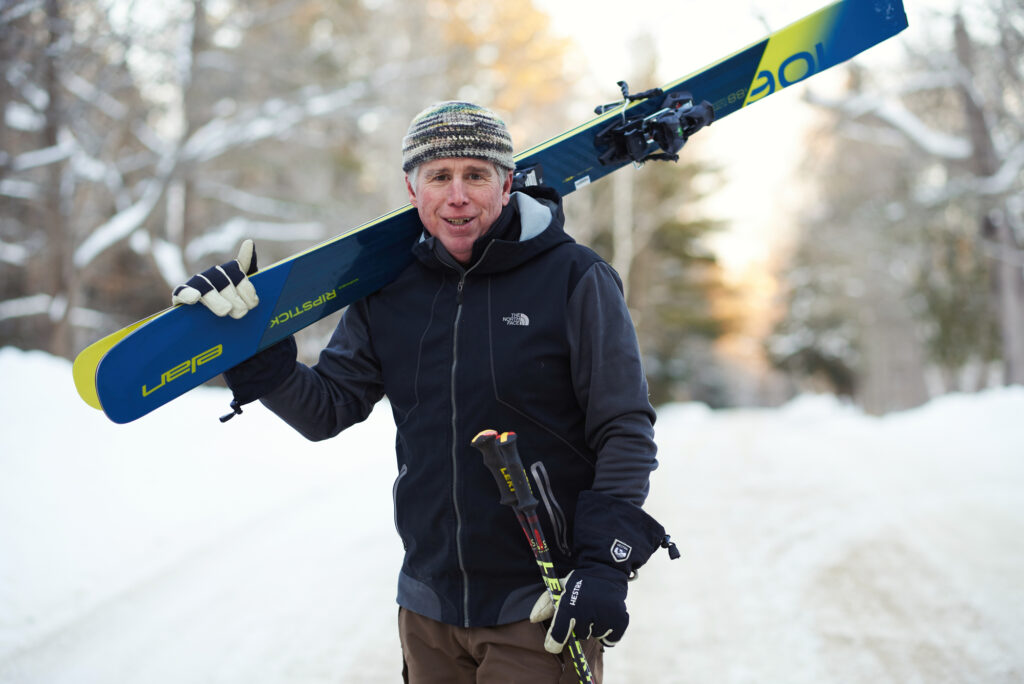
Dan today
Peter I’m just going to quote you from your book here. ‘I jump my first clip of Mad River Glen area in Vermont in the early 1980s. Since that day, I’ve been hooked on the thrill of heading towards the edge of a cliff and flying off it. I’ve come to call it the eternal Now, when everything slows down and then, bang, you land in a pillow of snow. I got a taste of that feeling and wanted more.’ Can you can you tell us in your own words why skiing is so important to you?
Dan Yes, I think what skiing represents in a lot of ways, and I think for many people: freedom. The feeling of gliding on over and through snow is really amazing. From the moment you push off the lift, all decisions of yours – where you go, why you go there, how you go there, how fast you go there, how slow you go there. And the route down are all decisions you get to make.
So as a young boy, that was very empowering. Skiing and sailing played a big part of my life, because I think I could be independent. And then the thought of pushing over an edge of a cliff and surviving it, really became something that was curious to me: how high we could go, how fast could we go off it, how far could we drop? What did the landings need to be like?
My brother, John, and I have a very unique talent – we can stand on top of a very large cliff, throw a snowball and say our feet are going to land right there. You know, the cameraman would appreciate that because we could land within 12 inches of that spot, hit our marks and do it side by side next to each other, either one one behind the other or right next to each other. And that was extremely exciting for filmmakers like Warren Miller.
Peter One of the problems is staying alive, of course, because there’s extreme skiing developed, particularly in Europe, where I think you’d agree the mountains are steeper in lots of ways. We had a series of famous, very big stars like Patrick Vallencant and Jean-Marc Boivin, who all died in accidents of various types. But when you guys kept going and you developed it in North America in a slightly different way, right?

Dan We did.Patrick was a big inspiration for us. So was Jean-Marc Boivin, Sylvain Saudan, all these guys were our heroes. We had their posters. John met Patrick in Chamonix. But you know, what I say is that like all things in America, we glitz and glamoured extreme skiing – we packaged it, we sponsored it, we MTVd it. I think the descents in Europe were a little bit more radical than what we were doing, they were more of the Alpinist tradition.
I tie our roots back to the free style movement of the 70s. It was more of an expression in America than it was sort of the pure alpinism of Europe, and that was always a big debate going on. I still think it goes on today. But for me – and I think that was part of the learning curve in Europe as well, when I went went to Elbrus – maybe what they were doing in Europe was slightly different to what we’re doing in America. And I had to ponder that for a long time.
Felice And you and your brother have made more than 50 first descents around the world, is that right?
Dan It’s true, yes. We were known for skiing the most remote regions of the world. Been up to the Arctic twice, we skied all throughout Europe, South America, Greenland, Russia, and we documented a lot of first descents. And again, those were radical lines and radical places where rescue really wasn’t an option. So I think often a first descent or an extreme descent has to do with the situation around it, not always the pitch of the slope.
Felice Have you ever been really scared?
Dan Absolutely, yes, I mean, fear is a motivator, right? And in my lectures and my talks, I talk about rational fear deserves a rational response. So if you’re scared, make sure you do it right. The irrational response would be to do it wrong. I always use fear as a trigger to really focus in and execute technique, make good decisions. Wouldn’t say that we were ever above making mistakes, but fear for me was a motivator rather than a limiting factor.
Felice You pioneered heli-skiing in Chile, is that right?
Dan We’re definitely one of the some of the first heli-skiers in South America. Our good friend ran the resort in Valle Nevado, and he was a Sugarbush skier and the whole ski school down there were Sugarbush instructors. So we had a great operation in Portillo and then we went over to Val d’Isère. I don’t know that we were the first, but we were the first to really bring a lot of Americans down to the heli-skiing in South America. And we were the first heli-skiers in Ushuaia and the southern tip of Argentina. John pioneered heli-skiing in Greenland, he set up the operation in Greenland that’s still operating today. So we were always on the edge of the travel experience and the on-snow experience.
Peter Yes, I remember when Felice and I were skiing in Valle Nevado, a heli-skiing with a guide from Courchevel in France, who had been coming there every year for years and he knew it very well. And we got out the top of the mountain, just the three of us, I think, four of us, we landed and a lovely sunny day. We got out of the helicopter and he said some very important things.
He said, ‘Firstly, guys, you can all ski, but you have to remember to breathe on every turn. If you don’t breathe, you’re going to fall over,’ which is very true. And I looked up above us where the helicopter landed on quite a wide little plateau and it was a beautiful slope above us look really inviting. And I said, ‘Why can’t we got there?’ And he said, ‘I’ve always wanted to, but we can’t.’ I said, ‘Well, why?’ He said, ‘Because the helicopter can’t get there.’ And that sums up how high you are.
Dan You know, it’s really true. I mean, when you’re heli-skiing in the high…I think the highest we ever took the bird down there was almost 14,000, maybe a little bit more…14,500, they struggle a bit. And so, yes, that’s always a bit of a tease, isn’t it?
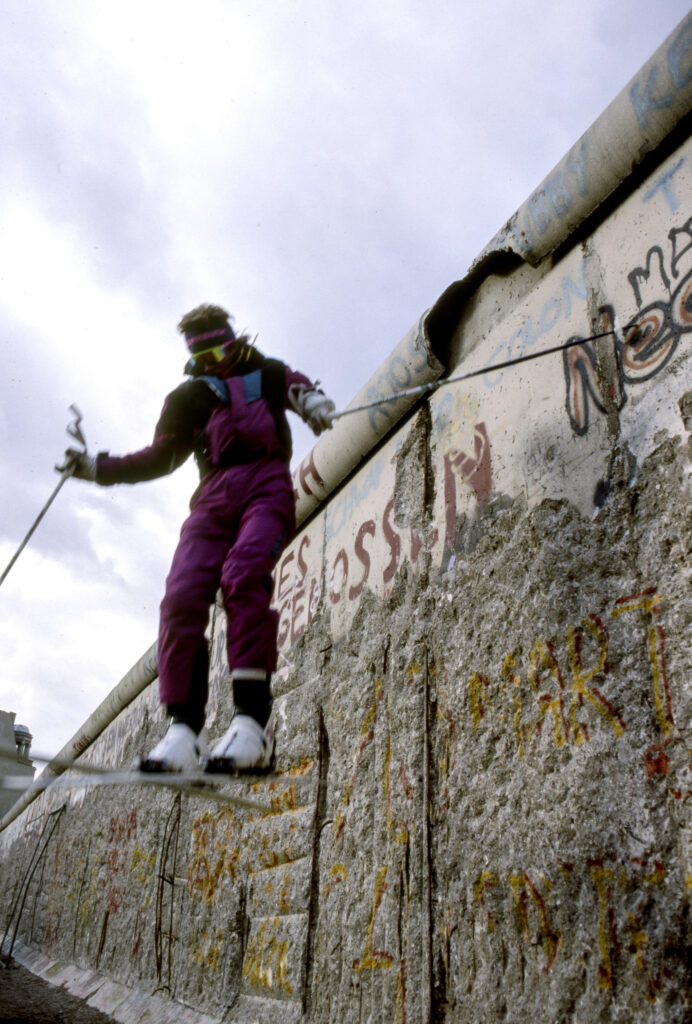
Dan jumping off the Berlin Wall
Peter This was about that – about 15,000. Now other things: you’ve done extraordinary things. The Berlin Wall, tell us about that?
Dan Well, my ski career, I went to Warren Miller, early when I first started working for Warren and I told him I wanted to follow CNN around the world. I wanted to go to where world events were happening. And we had been working in Val d’Isère there that winter filming and we were getting kicked out of our apartment, we couldn’t afford it for the February break. So we borrowed a van, quote unquote, and decided that we would head to the Berlin Wall and jump off it.
Of course, there’s not much snow in Berlin. And we took this borrowed van that had no papers, no insurance, no registration, drove all the way over there. We had seven nationalities in the van and a small baby, a three year old. And it was a little bit of a stunt, of course, but it was also a point that skiing represents freedom. And I think for me, one of the most memorable times was when we jumped into no man’s land, landed in a dirt patch, and a bunch of East German guards pulled up to us. And, you know, normally they would have shot you just months before us being there.
None of them had guns. They were looking at a bunch of young American kids in bright clothes and skis, they were dumbfounded by why we would be doing this, and they pushed us back through the Wall. But just that interaction with them was beautiful. And to think about standing in no man’s land, where others weren’t able to escape it, was very impactful. It was right after the Wall came down.
Felice Have you jumped off anything else without snow?
Dan You know, I’ve skied into moving vans. I’ve jumped into pools and done some big jumps over buildings and things like that. But, yes, that was probably the most historic place we jumped.
We pursued that, that idea of going wherever CNN was, we went to ski with the Kurds during the first Persian Gulf War on the border of Turkey and Iraq. We were in Yugoslavia a week before the war started. And when Slovenia broke away, we skied in Romania after the death of Ceausescu. So we would kind of link ourselves to these world events and try and bring a wider audience to our ski filmmaking.
Felice Hmm, that’s interesting.
Peter And you thought that Chamonix would be your favourite resort in Europe, but it’s not, is it? It’s Val d’Isère.
Dan It’s not. Well, I do love Val d’Isère. Val is really special spot. Of course, my good friend Henry from Henry’s Avalanche Talks lives there – we grew up racing together in Boston and have known each other since we were teenagers and it’s pretty amazing that two kids from the city became professional skiers. But we taught our camps in Chamonix for 25 years and we brought people into Chamonix for a very long time.
For a lot of years, we would do Chamonix and Val d’Isère. But Chamonix, as you know, has changed a lot over the years. And that lift system in Val d’Isère is really second to none – the ease to move around the resort, the shuttle system’s amazing in town…and so it’s just has become a friendlier place for me to kind of make my springtime home. I’m there about four or five weeks every year now.
Felice So where do you see yourself in the next five years? What do you think you’ll be doing then?
Dan That’s a question I’ve been getting since probably since my college graduation. People would ask that question and the best answer I have is I never want to predict because I don’t want to sell myself short. I have a track record of going beyond my wildest dreams, and I hope the next five years will do that as well.
I have another book planned called Dying To Ski. It documents the loss of my 25 professional ski friends who have passed away while working. And I think that these people need to put that into context, how it came to be – the birth of the Red Bull generation to GoPro generation. All of this starts basically from…I follow these deaths from the late 80s, early 90s through current day and tie them together.
I’m working on a documentary on Clyde Best, the soccer player who played for West Ham, who lives in Bermuda, who I got to meet during the America’s Cup down there in Bermuda. And of course, I’ll keep skiing for sure. My winter home is here in Big Sky, Montana, my springtime home in Val d’Isère. And I still ski with a lot of people. People want to come and ski with me. They can. And if they don’t, I’m out there skiing anyways.
Felice If people want to buy your book, where can they buy it?
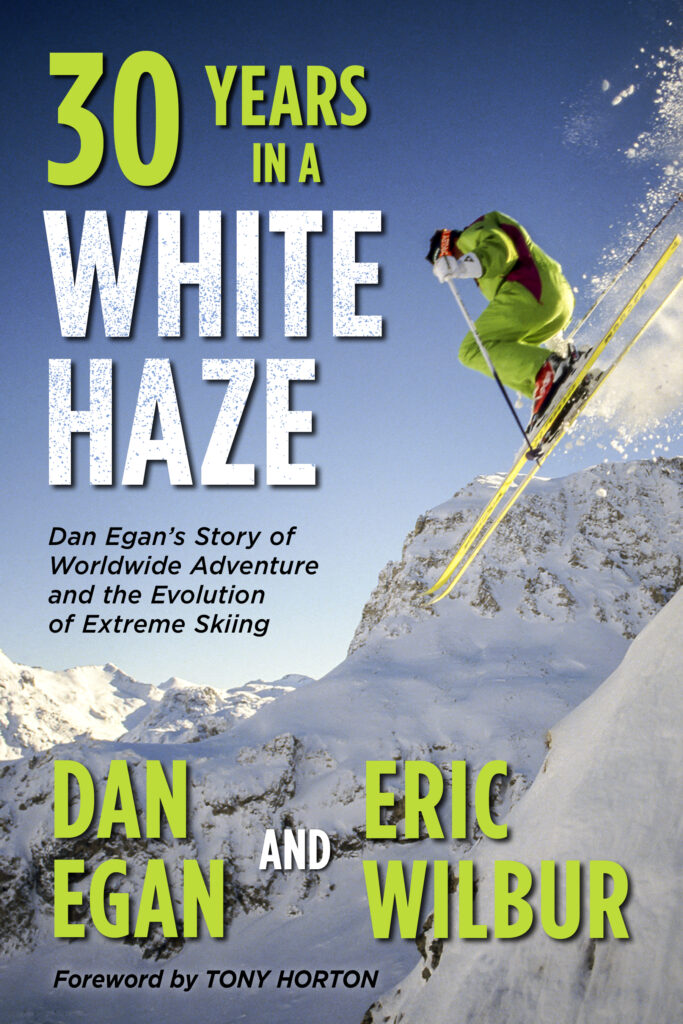
Dan The book’s available on Amazon, on Barnes and Noble, on all the big retailers. It is also available at white-haze.com and if, of course, if you just Google ‘Dan Egan White Haze’, it pops right up. Shortly we’ll also have the audio book and the Kindle book. Next Fall, we’re going to release a special limited edition hardcover copy of the book. The book’s really special, you know, it has a lot of different elements in it. Of course, it has our story in it but each chapter opens up with beautiful illustrations done by five different illustrators and artists from around the world.
Peter And your ski clinics, if someone wants to join, how do they get hold of you?
Dan Yes, of course. And I’ve always enjoyed skiing with both of you. So my camp are at Skiclinics.com – you can find our camps there, we do camps in the East Coast, we do camps here in Montana, we do Learn to Heli-Ski camps in Victor, Idaho. We do Mastering the Skiing Mind in Aspen, Colorado. And of course, all spring you can come ski with me from mid-March all the way to May 1st in beautiful Val d’Isère, France.
Peter Dan Egan thank you very much indeed for appearing on the show and we wish you the very best of luck with your skiing career in the future.
Dan Thank you so much. Great to see you and hope to ski with you again real soon.
Peter Yes, absolutely. Looking forward to it.
For more information about the book and where to buy it, click here. See also our posts on ski racer turned photographer, Konrad Bartelski and veteran ski writer, Arnie Wilson.
Felice That’s all for now. If you’ve enjoyed the show, please share this episode with at least one other person! Do also subscribe on Spotify, i-Tunes or any of the many podcast providers – where you can give us a rating. You can subscribe on Spotify, Apple Podcasts or any of the many podcast platforms. You can also find us on Twitter, Facebook and Instagram. We’d love you to sign up for our regular emails to [email protected].
© ActionPacked Travel

- Join over a hundred thousand podcasters already using Buzzsprout to get their message out to the world.
- Following the link lets Buzzsprout know we sent you, gets you a $20 Amazon gift card if you sign up for a paid plan, and helps support our show.
